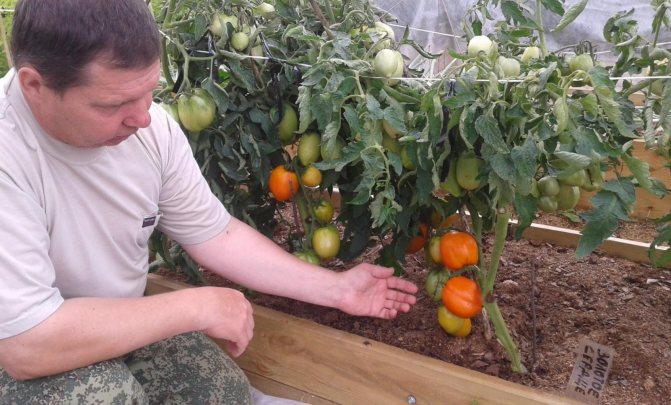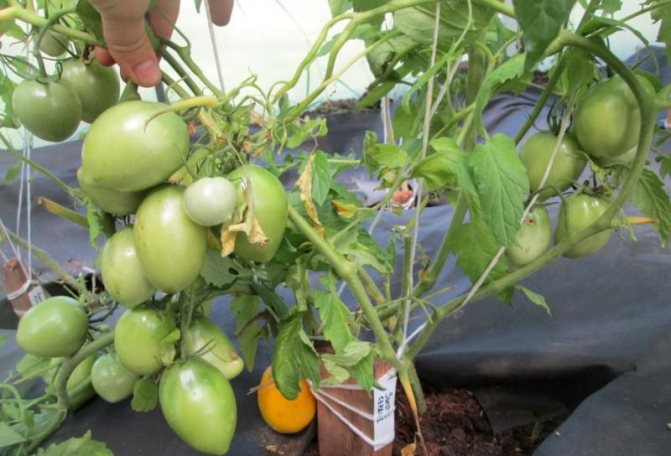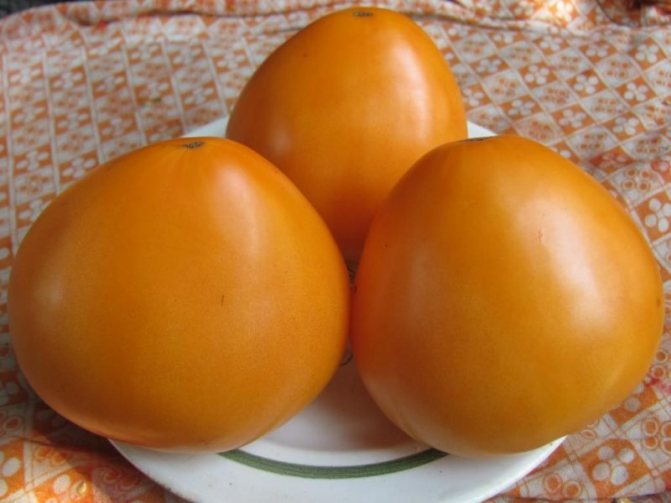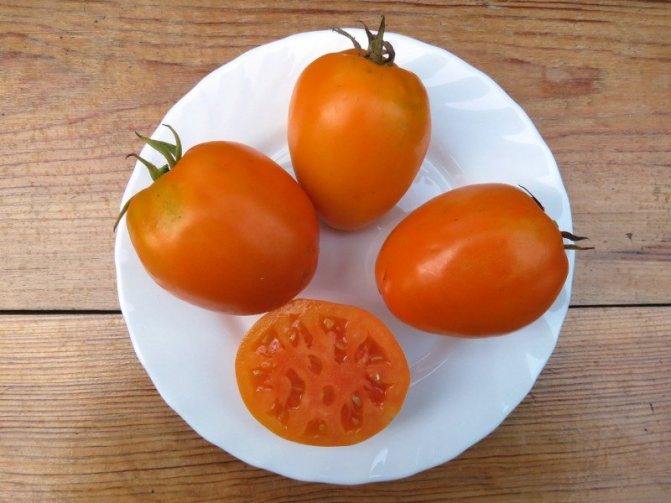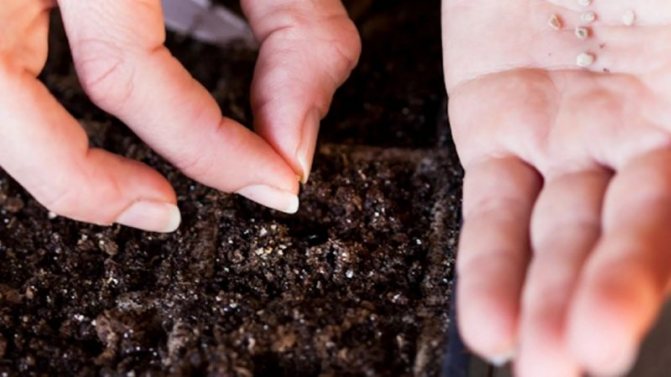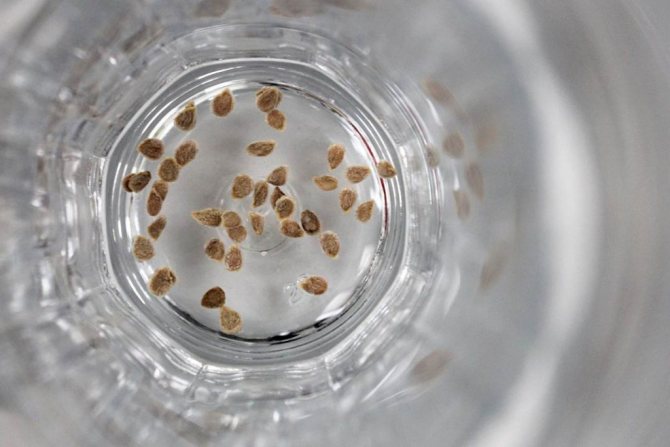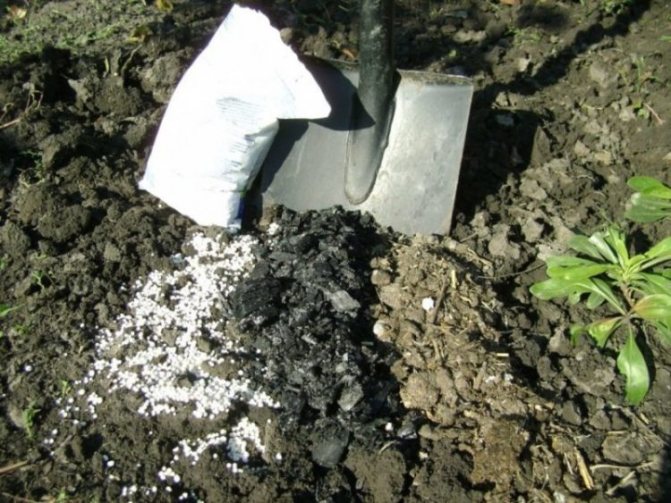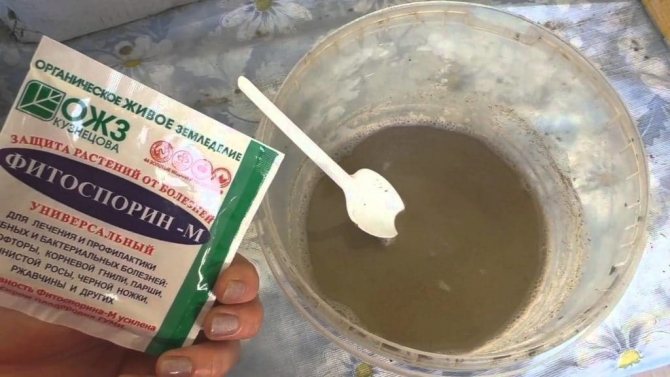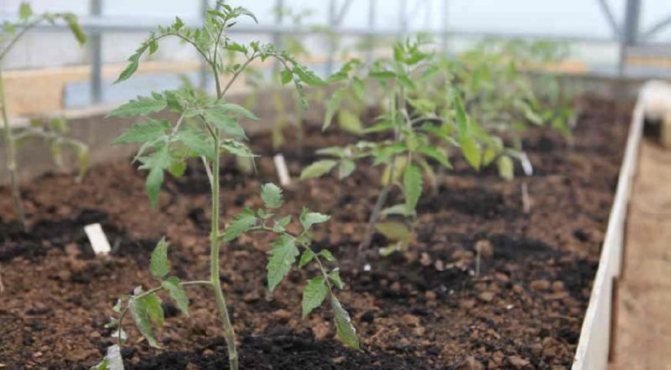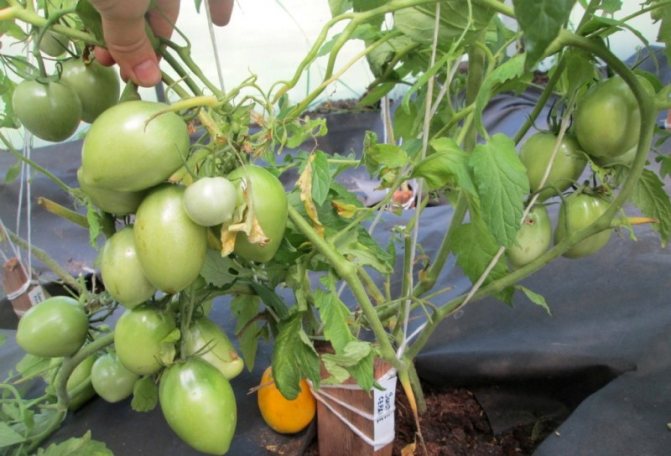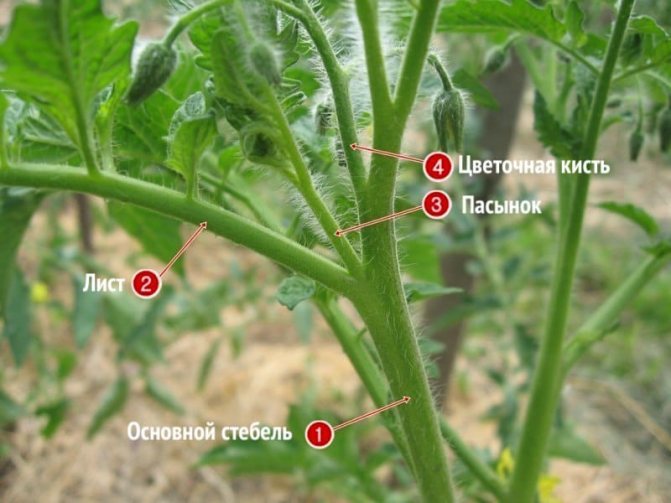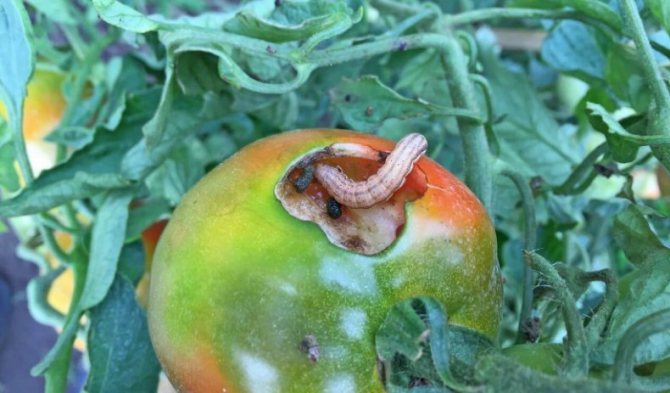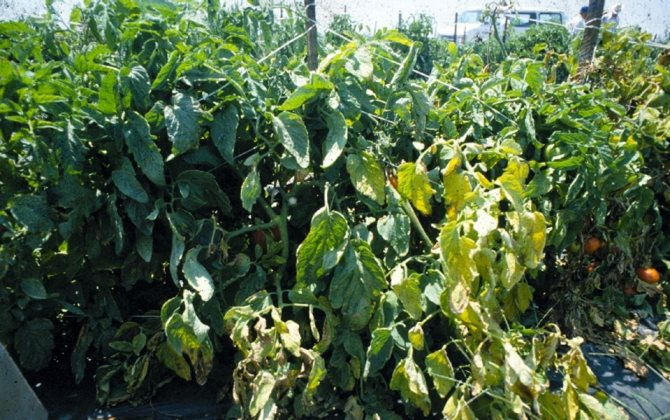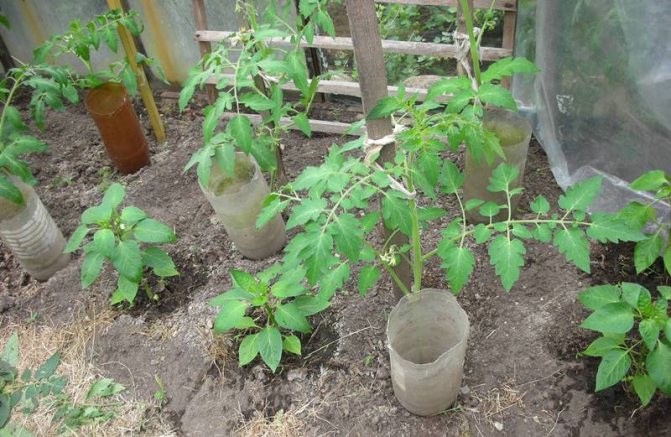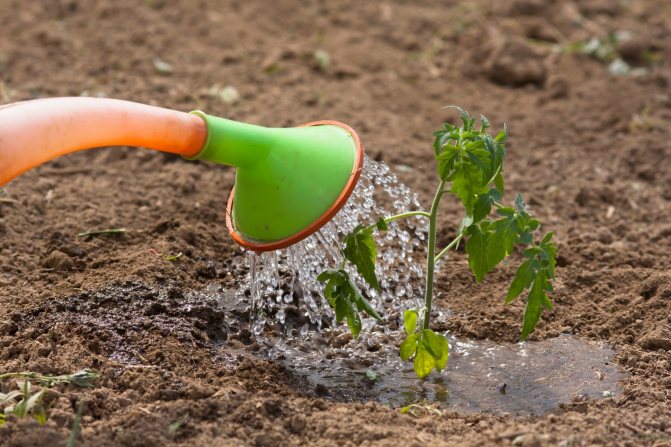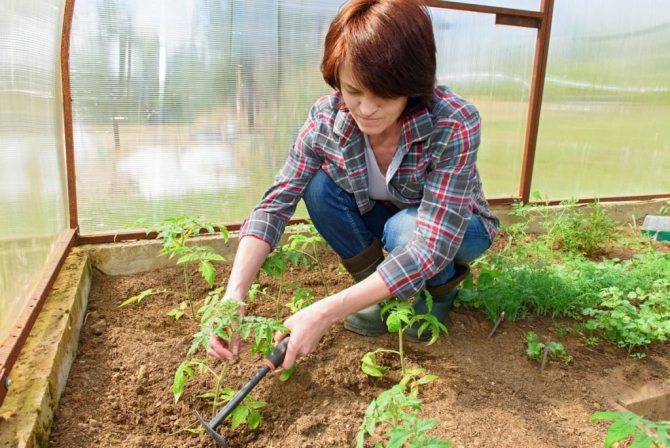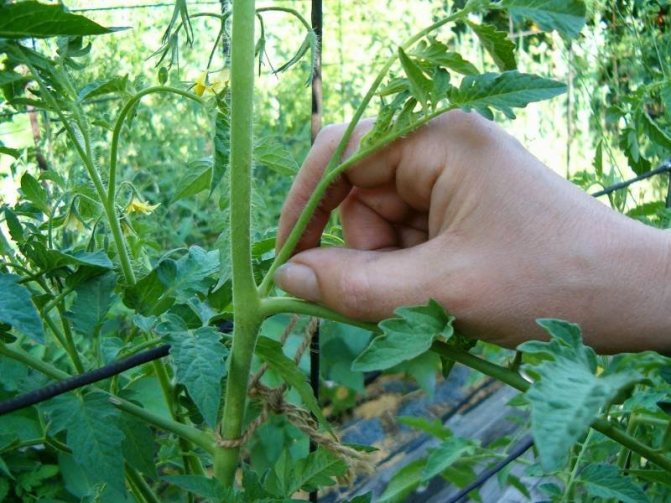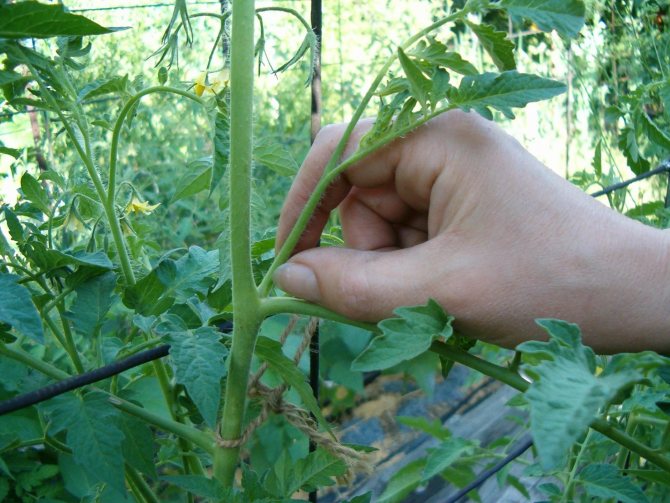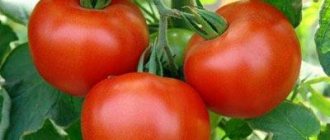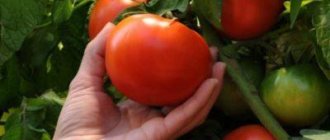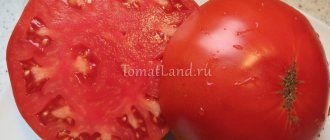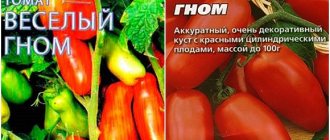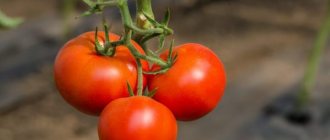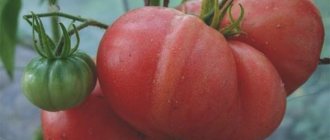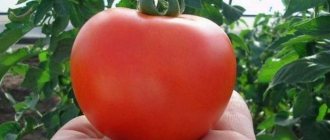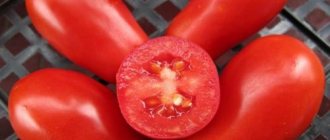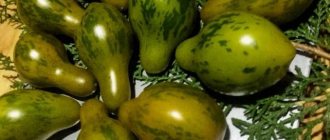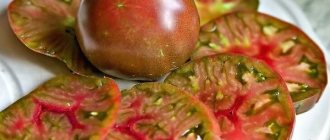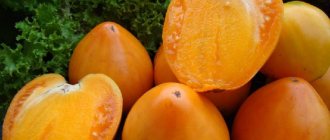Tomato Golden Heart belongs to the early maturing varieties, it always gives an excellent harvest. Why do you think it has such an unusual name. Yes, you are right, its fruits look like a heart of gold, or rather, a yellow-orange one. This variety was entered into the State Register in 2001, and bred by a Russian breeder. Today we will introduce you to the description of the variety, planting order, care rules, so carefully study our article. We promise that the information will be extremely interesting and useful. Especially for avid gardeners.
Description of the variety
The shape of the fruit is oblong, tapering downward, with noticeable ribs, the so-called heart-shaped. This function is reflected in the name of the variety.
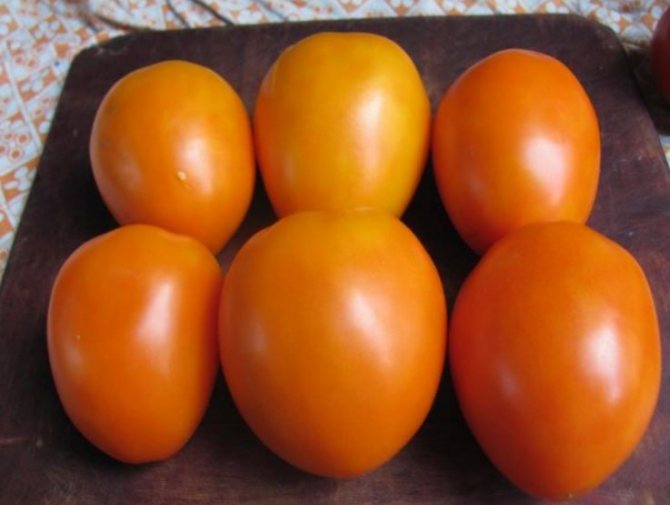
Big size:
- in the open field - up to 150 grams;
- and in a greenhouse - up to 300 grams.
The color is sunny, orange-yellow. The skin is firm, but not thick, and the variety also has the following characteristic features:
- The pulp is very good, fleshy, there is little seed in it.
- The taste is excellent, rich and sweet, almost acid-free and with a pleasant aroma.
- The fruit contains more carotene than regular red varieties. Thus, the Golden Heart tomato is considered dietary, it is recommended for baby food, it can be used for making juices and other canned food.
- Its high density makes it suitable for freezing sections.
- Ripening very early, from the emergence of seedlings from seed to ripening of the crop takes about three months. A well-known technique that increases productivity is the practice of picking unripe tomatoes and sending them into boxes. The quality and tolerance of the fruit are excellent.
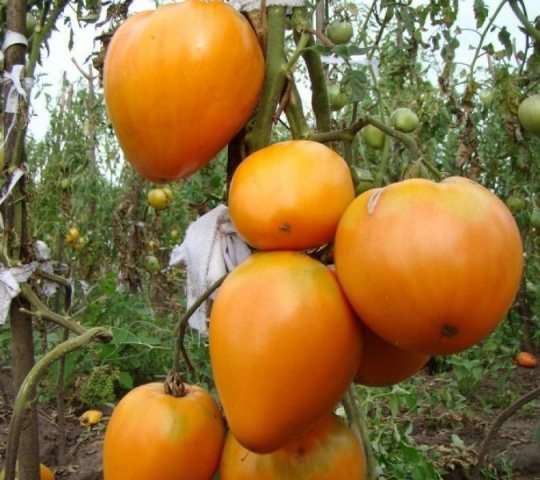

- Plants with limited height. Usually they grow up to 80 centimeters on open ground, and in greenhouses with more even and favorable conditions - up to 120 centimeters. The variety is small, simple in shape and dark green in color.
- According to gardeners, the Heart of Gold is a very hardworking variety, it is rich in fruits. The brush contains up to 6-7 pieces.
About landing
As we noted earlier, the Golden Heart tomato can be grown on the territory of almost all of our country, with the only difference, somewhere it is better to plant a tomato in a greenhouse, and somewhere it can be sent directly into the open ground. Tomatoes are usually grown in seedlings, but in the south they can be immediately planted outside. In order to plant seedlings, you must first select the seed material.
Remove all deformed and empty seeds, treat them with a weak solution of potassium permanganate and soak in warm water in order for the sprouts to form faster. Seeds begin to be planted on seedlings at the end of winter, since tomatoes of this variety grow slowly. Seedlings are planted in open ground after about 2 months from the moment of disembarkation in boxes. In order for the plants to grow better, they are dived into separate containers.
Soil for seedlings is prepared either independently or bought in a specialized agricultural store. If you decide to prepare the ground for planting yourself, it is advisable to add humus, sand or peat to the soil. With the help of these components, you will make the soil looser, which means that the seeds will germinate more actively.
Before planting tomatoes, the soil should be roasted in the oven in order to get rid of weeds.Sometimes seeds are placed in warm water for a day with the addition of salt and Fitosporin. This is done so that plants develop even more intensively in the future. The furrows for planting seeds should not be deep, about one centimeter, leave at least 4 cm between them, and up to a centimeter between the seeds. Water the seedlings abundantly with water, it is advisable to cover the seeds with dry soil on top. Cover the container with seedlings with foil or glass and place in a warm place. After about 5 days, they can be moved to the windowsill. It is best to spray the soil with a spray bottle to moisten it.
Remember that the seedlings need to be provided with good light, every day for 12 hours. If you don't have enough natural light, then build an artificial backlight. You can transfer the seedlings to the greenhouse already at the beginning of May, before that, you should dig up the soil and apply the appropriate fertilizers there. The topsoil is recommended to be disinfected with a solution of copper sulfate. Many gardeners recommend immediately adding superphosphate soil, potassium nitrate, wood ash and potassium magnesium. As you remember, the Golden Heart has a compact bush, so it is very convenient to grow them in a greenhouse. No more than 4 seedlings can be placed on one square meter. It is best to do this in a checkerboard pattern, so the plants will have enough free space, and it will be easier to care for them.
It is recommended to plant tomatoes in open ground only after the establishment of good weather, frosts are very dangerous for plants. Each seedling should have at least 6 healthy and strong leaves, the seedling height should be at least 30 cm. If your plants fit these parameters, then you can plant them in open ground. But remember, 2 weeks before the expected date of planting, you should begin to harden the culture. To do this, place the boxes on the balcony or outside, increasing the time the seedlings stay outdoors. It is best to plant tomatoes in areas that are well lit by the sun; tomatoes also do not like drafts. If we talk about plants that grew on the site before the appearance of tomatoes, then you should not choose eggplants, potatoes or peppers as precursors. Prefer legumes, cabbage, and carrots. The beds are best prepared in the fall. For this, phosphorus and potash fertilizers, manure and humus are introduced into the soil.
But in the spring it will be necessary to loosen the soil again, dig holes. You need to place seedlings in the planting holes, moisten the soil abundantly, cover the holes with earth and compact the top layer of soil. After that, it is advisable to mulch the trunk circles.
Characteristics of the variety
The Golden Heart tomato variety was bred by Russian breeders. The yellow color of vegetables is not chosen by chance, because the pigments are excluded from the tomato, which can cause specific reactions in the human body (allergies). Yellow fruits contain a lot of iron, in addition, the composition of tomatoes is no less vitamin C than citrus fruits. The description of the variety makes sure that the beta-carotene substance in the fruit will strengthen the cardiovascular system, hair and nails.
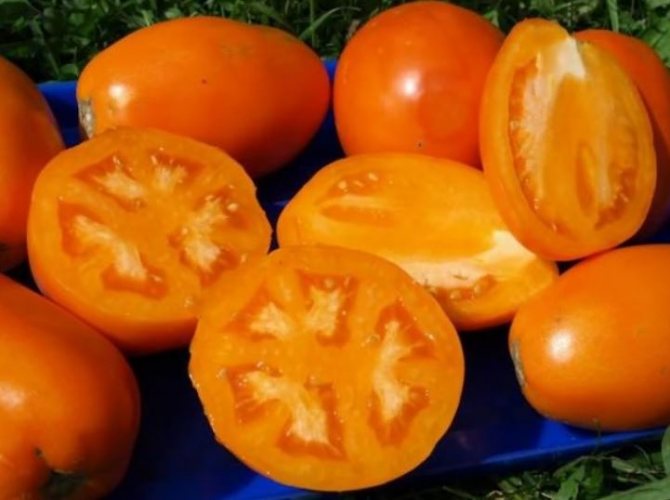

Grow this variety of tomatoes in open areas in any regions of Russia, with the exception of the northern regions. At the same time, deterministic bushes thrive in greenhouse conditions.
Features of the fetus
Each cluster grows and ripens 6-7 fruits. Reviews of vegetable growers confirm that from 1 m2, with proper care, up to 7 kg of tomatoes can be removed. The average fruit weight is 150 g, under favorable conditions a tomato can reach 200-220 g.
The taste of vegetables should be noted separately: sweet, rich, without excessive wateriness. Tomatoes are ideal for:
- for baby food;
- good in salads;
- the delicious taste of the vegetable does not spoil after heat treatment.
From these tomatoes you get:
- excellent juices;
- ketchup;
- tomato paste;
- suitable for salting and pickling.
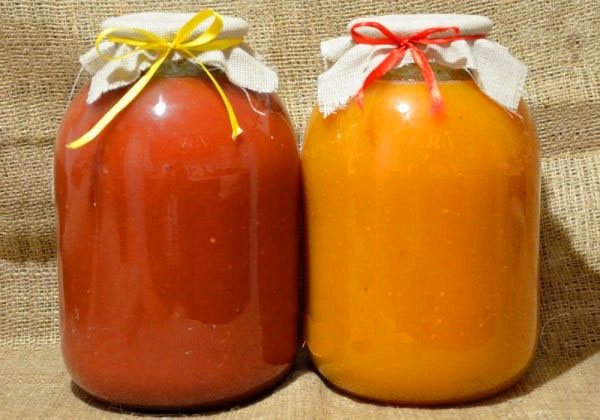

The described tomato variety has many positive qualities, among which experts identify yield, early ripeness, excellent taste. In this case, it is necessary to note the existing disadvantages. In particular, bushes of Golden Heart tomatoes need shaping.
Application
Tomatoes of the Golden Heart variety contain a lot of carotene, which is why it is included in the diet. Tomatoes are yellow in color, therefore they do not cause allergic reactions and can be used even by children. On their basis, children's purees and juices are prepared. The fruits have excellent taste, so they are recommended to be consumed fresh, added to salads and a variety of cuts. They also freeze well in pieces.
Golden Heart tomatoes can be pickled, salted, canned and added to various vegetable platters. They do not lose their taste when cooked, so they can be used when preparing hot dishes. They add not only flavor, but also beauty to the dish due to their rich orange color.
Overripe tomatoes can be processed and made into juice, pasta, and sauce.
Watch the video! Tomato Golden Heart
Growing features
Fertility of the soil is of great importance for the growth, development of plants:
- Planting tomato seeds and seedlings should be in good, nutritious soil.
- The best composition for a crop may be a mixture of garden soil and overlying humus, taken in a 1: 1 ratio.
- Turf, peat and river sand are another composition for planting this variety of tomatoes.
- Undecomposed organic matter can provide the splendor and lightness of the earth, humus (decomposition of vegetation) will darken the soil.
- However, the latter does not have free trace elements that the plant needs.
- But on black soil, tomato bushes develop well and do not lack mineral nutrition.
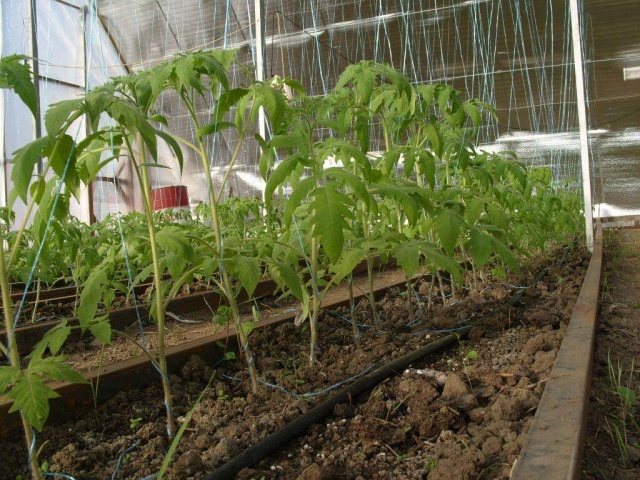

Do not overfeed the plantings with mineral fertilizers, their excess negatively affects the growth and productivity of tomatoes.
Grow plants in late March or early April. Before the seeds enter the soil, they are disinfected in a solution of potassium permanganate or hydrogen peroxide. The seeds are buried 1-2 cm, then moisten the soil with a sprayer and cover the box with seed film.
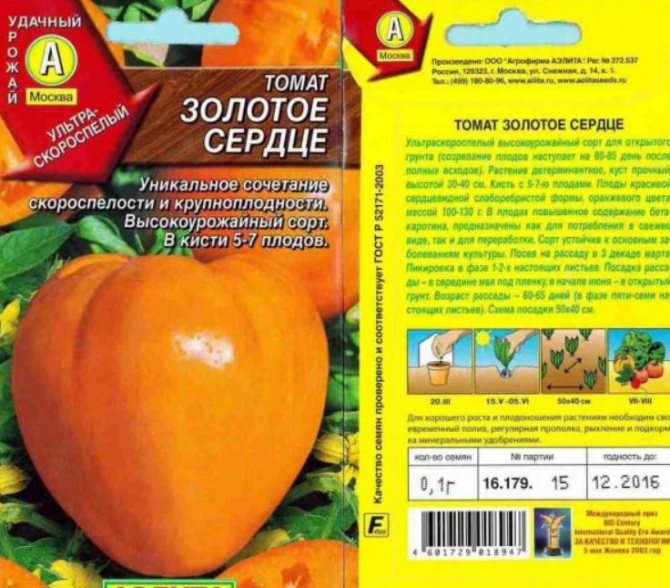

At a temperature of 22-24 ºС, tomato seeds germinate in 4-5 days, at this moment it will be necessary to do the following:
- The film must be removed and the seedlings must be placed in a well-lit area.
- Plants are picked after the formation of two true leaves.
- For the appearance of a good leaf mass on tomato bushes, measures should be taken to fertilize the seedlings with nitrogen-containing fertilizing.
- From mid-May, the prepared seedlings are transplanted to a permanent place: in an open area or in a greenhouse.
- Before sowing, the soil is prepared, it is watered with warm water and filled with wood ash. Up to three plants per m2. When the bushes grow, they are tied to supports and shaped into one or two stems.
- When leaving, it is necessary to loosen the soil in time to exclude the appearance of weeds. Mulching will help create optimal moisture for the plants.
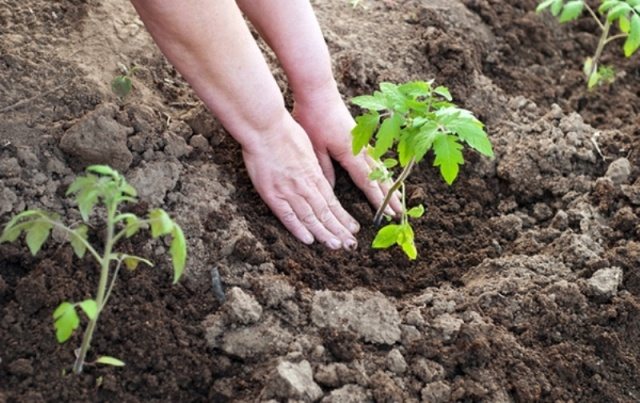

Diseases and pests
The Golden Heart tomato variety is not too sensitive to diseases, but preventive measures must be taken:
- Start by tilling the soil. In the greenhouse, the topsoil is replaced annually. If the seedlings are transplanted into open areas, it is important to choose the places that were previously occupied by:
- beans;
- cabbage;
- carrots or herbs.
You cannot use the land that was grown on:
- other varieties of tomatoes;
- potatoes;
- pepper;
- eggplant.
- For prevention, the soil is spilled with a solution of potassium permanganate or copper sulfate.
Copper sulphate
- Regular spraying of plantations with copper-containing preparations helps against late blight and fusarium wilting.
- You can get rid of the fungus with a pale pink potassium permanganate solution. It is important to ventilate the greenhouse in a timely manner, remove weeds and cut off the lower leaves of the tomatoes. The more fresh air, the greater the guarantee that the plants will not become infected with top or root rot.
- Having found darkening or curling of leaves, it is necessary to promptly remove the damaged parts of the plants, and then spray the plantings with phytosporin or other non-toxic biological product.
Large damage to plantings is caused by insects. Tomatoes are under threat:
- aphids;
- thrips;
- whitefly;
- spider mite.
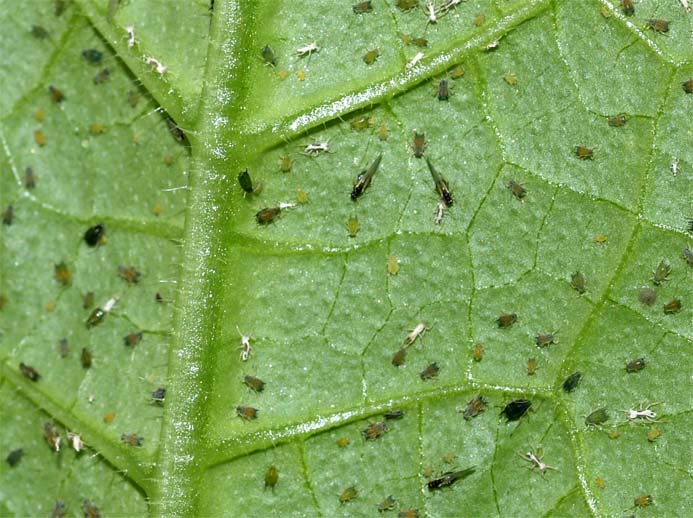

Aphid
In the beds, slugs are waiting for young plants, destroying fresh greens. Spraying the plantings with an aqueous solution of ammonia will help get rid of them. Soapy water will help from aphids, mites destroy modern insecticides or a decoction of celandine. As for the Colorado potato beetle, you can use chemicals to control it:
- Aktara;
- Corado;
- Regent;
- Commander;
- Prestige;
- Lightning;
- Tanrek;
- Apache;
- Taboo.
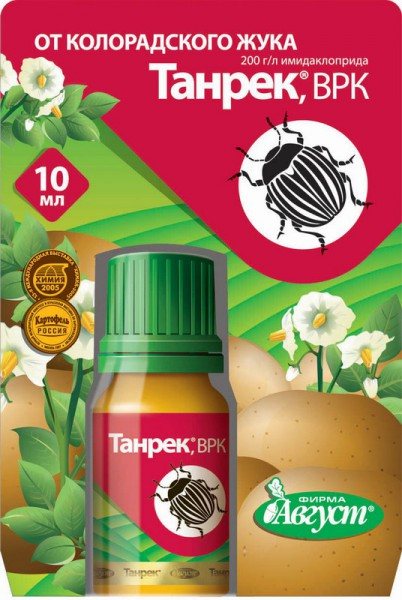

Tomato care
Tomatoes need regular maintenance, which consists of maintaining moisture, watering and feeding. To form a bush, it is pinned. An adult plant is tied to a support.
Watering
The Golden Heart tomato is picky about soil moisture, but they prefer dry air in the greenhouse. Excessive moisture causes the development of fungal diseases, and excessive watering leads to decay of the root system.
Important! Tomatoes are watered once or twice a week, depending on the stage of development.
After transfer to a greenhouse or soil, the plants are watered abundantly. The next application of moisture is carried out after 10 days. Each bush requires 2-4 liters of water.
The Golden Heart variety is watered in the morning or evening, when there is no exposure to sunlight. It is important to keep moisture away from the green parts of the plants.
During flowering, tomatoes are watered once a week, and up to 5 liters of water are added. When fruits appear, watering is carried out twice a week, each bush requires up to 3 liters of moisture.
Top dressing
During the season, tomatoes require the following feeding:
- 2 weeks after transfer to a permanent place, the tomatoes are fertilized with nitrogen fertilizer. A bucket of water requires 1 tbsp. l. urea. The solution is poured over the plants under the root (1 liter for each bush).
- A week later, liquid chicken manure is introduced (0.5 liters per bucket of water). For each bush, 1 liter of the resulting mixture is enough.
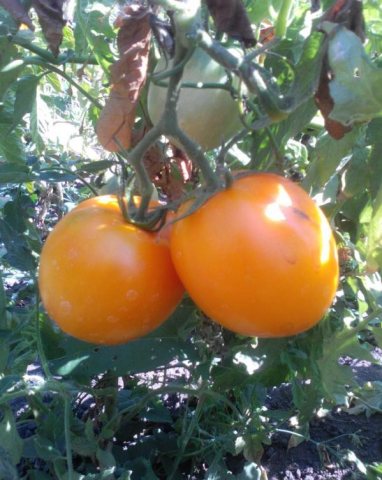

- The next top dressing is during the flowering period. Furrows should be dug along the bed and ash should be poured. Then it is covered with earth.
- When the third cluster blooms, tomatoes are fed with potassium guamate. For 10 liters of water, 1 tbsp is taken. l. fertilizers.
- During the ripening period, the planting is sprayed with a superphosphate solution. For 1 liter of water, 1 tbsp is measured. l. of this substance.
Stepson and tying
As a result of pinching, excess shoots are eliminated, which take away the strength of the plant and require nutrients. So on the bushes get larger fruits.
The stepson grows out of the leaf axils. Therefore, it is necessary to break off the upper process, which has not reached a length of 5 cm.
Hand-picking is done by hand so as not to injure the plant. Be sure to leave up to 3 cm of the length of the sheet, so as not to provoke the development of a new stepson.
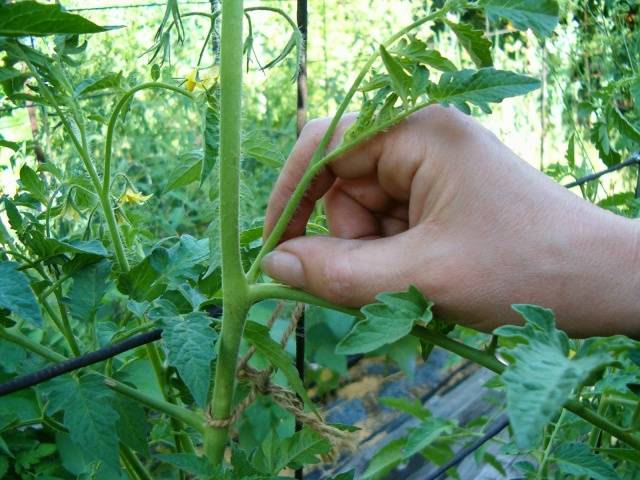

The Golden Heart variety is formed into two stems. Therefore, one of the strongest stepson, located under the first flowering brush, must be left.
As the tomatoes grow, it is necessary to tie them up so that the stems do not break under the weight of the fruit. To do this, a support made of wood or metal is driven into the ground. The bush is tied up at the top.
Protection against diseases and pests
According to the photo, reviews, who planted the Golden Heart tomato, the variety has an average resistance to diseases. For prevention, tomatoes are sprayed with preparations containing copper.
When darkened or twisted leaves appear, tomatoes are sprayed with Fitosporin or another biological product. The damaged parts of the plants are removed.
Tomatoes are attacked by thrips, aphids, spider mites, whiteflies. Insecticides are effective against insects. It is allowed to use folk remedies: a solution of ammonia, an infusion on onion peels or a decoction of celandine.
Compliance with agricultural practices will help to avoid the spread of diseases and pests:
- airing the greenhouse;
- elimination of weeds;
- compliance with watering rules;
- soil mulching with humus or peat.
Photo
For a more detailed study of the Golden Heart variety, you can view the photos below.
You can also watch a video where an experienced gardener will tell you how he managed to grow the Golden Heart variety in a greenhouse.
Heart of Gold is a great variety for experienced and novice gardeners. With due care, it will not disappoint, providing excellent yields throughout the summer. Tomatoes practically do not get sick, they can give seed material for subsequent planting.
Advantages and disadvantages
Among the main advantages it is worth noting:
- high palatability of fruits;
- attractive appearance;
- an abundance of useful trace elements in fruits;
- versatility of tomatoes, they can be eaten fresh, canned, widely used in cooking;
- excellent productivity;
- resistance to late blight, fusarium, verticillosis, alternaria;
- cold tolerance, drought resistance;
- compact bush saves space in the garden.
The yields of other varieties are presented below:
| Variety name | Yield |
| Golden heart | 7 kg per square meter |
| Visibly invisible | 12-15 kg per square meter |
| American ribbed | 5.5 kg per bush |
| Apples in the snow | 2.5 kg per bush |
| Market King | 10-12 kg per square meter |
| Early love | 2 kg per bush |
| The president | 7-9 kg per square meter |
| Samara | 11-13 kg per square meter |
| Nastenka | 10-12 kg per square meter |
| Baron | 6-8 kg per bush |
| Apple tree of Russia | 3-5 kg per bush |
Among the difficulties of the Golden Heart variety, the need for pinching and forming a bush and the high demands of tomatoes on soil nutrition and irrigation schedule. The more care of the bush, the higher the yield and the larger the fruits.

